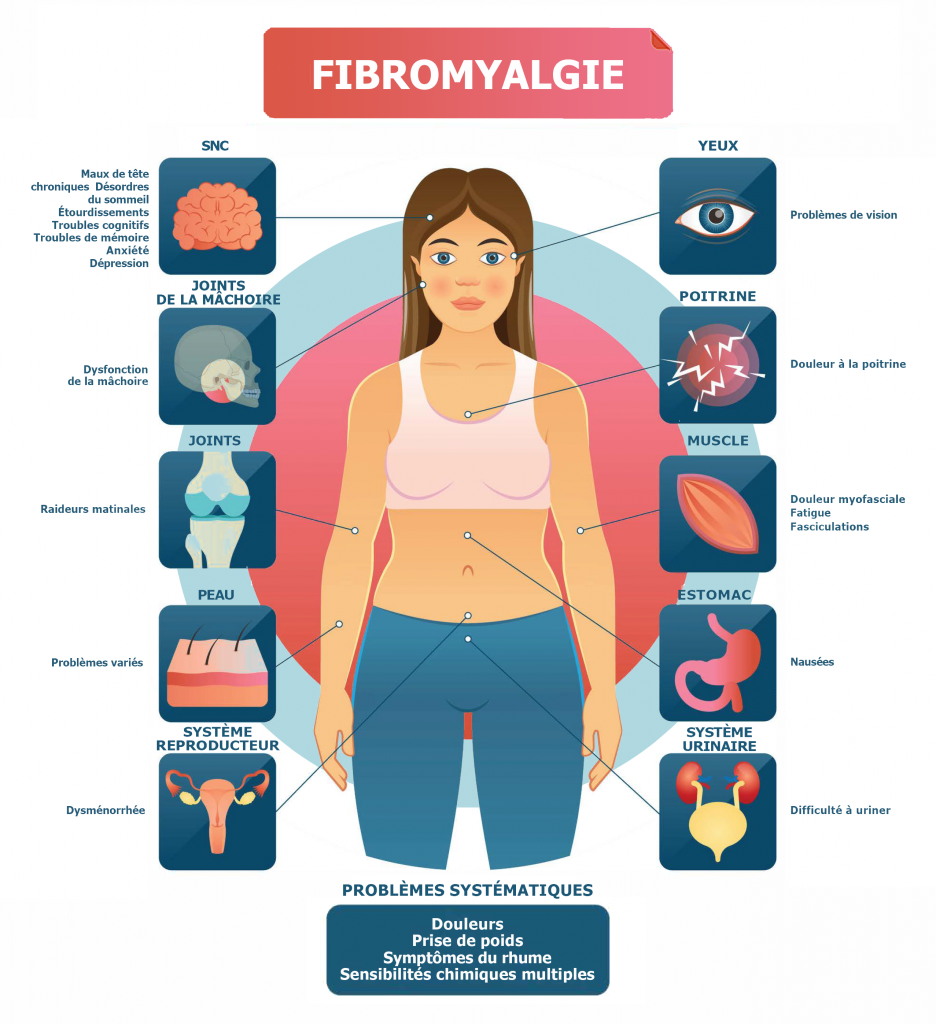La fibromyalgie (FM) était autrefois considérée comme une maladie mentale, mais elle est maintenant vue comme était une vraie condition physique. La fibromyalgie peut provenir de diverses facettes biologiques. Malgré le fait que les principales causes soient encore étudiées par les chercheurs, la science a tout de même fait beaucoup de chemin. Tous présentés dans l’un des articles du blogue de Vitoli Fibromyalgie, article 2 : les causes, il existe trois causes bien décrites liées à cette maladie :
- L’hypersensibilité centrale : une source chronique de douleur (différents types possibles) qui finit par causer un dérèglement de la gestion de la douleur par le cerveau qui se met alors à interpréter différents stimuli (souvent de perception) comme étant de la douleur.
- Une trop grande pression dans le liquide céphalo-rachidien.
- Une destruction des petites fibres périphériques (neuropathie périphérique).
Selon la Société canadienne de l’arthrite, « La FM est une maladie relativement courante puisque 2 % des Canadiens en sont atteints. Bien que la FM touche principalement des femmes (de 80 à 90 % des personnes atteintes de FM sont de sexe féminin), les hommes, les adolescents et les enfants peuvent également en être atteints. » L’image ci-dessous présente les nombreux symptômes de cette maladie.

Source de l’image : Open Medecine Foundation Canada, Qu’est-ce que la fibromyalgie?
https://omfcanada.ngo/quest-ce-que-la-fibromyalgie/?lang=fr
Heureusement, il y a des facteurs aggravants associés à la fibromyalgie tels que les déficits en antioxydants, les dysfonctions des mitochondries, les facteurs inflammatoires, etc., qui ont mis en évidence des domaines dans lesquels il serait possible, un jour, de trouver un traitement ciblé qui en découlerait. Un récent article scientifique a exploré plus en profondeur ces facteurs aggravants à la recherche d’un traitement possible pour la fibromyalgie : Hydroxytyrosol as a promising Ally in the Treatment of Fibromyalgia (Ramírez-Tejero et al., 2020) qui peut être traduit ainsi : L’hydroxytyrosol, un allié prometteur dans le traitement de la fibromyalgie.
Ramírez-Tejero et ses associés ont réfléchi à ces facteurs aggravants, principalement ceux liés aux facteurs inflammatoires et aux dysfonctionnements des mitochondries. Ils ont émis l’hypothèse qu’une diète qui corrigerait le déficit en antioxydant aurait le potentiel de renverser les effets de la fibromyalgie. Dans cet article, ils se sont spécifiquement intéressés à la diète méditerranéenne due à sa forte teneur en antioxydant et à l’utilisation fréquente de l’huile d’olive extra vierge (HOEV). L’HOEV a été reconnu pour avoir plusieurs bénéfices pour la santé – plus spécifiquement l’hydroxytyrosol.
L’hydroxytyrosol est considéré comme l’un des plus importants polyphénols en quantité et en bénéfices santé. Consultez les articles suivants qui sont disponibles sur le blogue de Vitoli pour obtenir plus d’informations sur le vieillissement et l’hydroxytyrosol :
- Les polyphénols d’olives protègent du vieillissement (article 1 de 2)
- Les polyphénols d’olives augmentent l’espérance de vie? (article 2 de 2)
- Polyphénols d’olives et les produits Vitoli – article 1 : le vieillissement primaire
- Polyphénols d’olives et les produits Vitoli – article 2 : les bénéfices
Les recherches de Ramírez-Tejero et ses associés (2020), ont démontré que l’hydroxytyrosol pouvait rétablir l’état d’homéostasie des cellules ou du moins partiellement. Avant de courir à l’épicerie la plus près de chez vous et de commencer à dévorer toutes les bouteilles de HOEV et les contenants d’olives, rappelez-vous que la majorité des polyphénols d’olives restent dans l’olive durant son pressage. On estime qu’environ 95% des polyphénols restent dans le fruit et que seulement 5% se retrouvent dans l’huile pressée. De plus, lors de la consommation du fruit, la quantité des polyphénols extraits et absorbés durant la digestion n’est pas garantie.
Pour obtenir le bénéfice santé désiré, il faut plus que simplement la présence d’un ingrédient en particulier, mais bien d’avoir une bonne qualité ainsi que la quantité suffisante. Ce serait pertinent de considérer l’apport qui est consommé avec la diète méditerranéenne comme point de départ pour l’utilisation de l’hydroxytyrosol pour la fibromyalgie. L’Union européenne a établi cet apport à une dose de 5 mg d’hydroxytyrosol et de ses dérivés. Cette dose est aussi reliée à une allégation santé en Europe pour la réduction des risques de maladies cardiovasculaires.
C’est pour cette raison spécifique que le Complexe ProvitolMD (provenant d’une technologie brevetée) qui est présent dans tous les produits VitoliMD correspond à la dose recommandée par l’Union européenne d’hydroxytyrosol. De cette façon, un extrait pur et standardisé de polyphénol d’olives peut être incorporé dans un régime alimentaire de manière sécuritaire et efficace.
Donc, en ce qui concerne l’utilisation de l’hydroxytyrosol spécifiquement comme traitement/thérapie pour la fibromyalgie, plus de recherches devront être effectuées, mais les résultats sont très prometteurs. Ceci peut expliquer, du moins en partie, les effets positifs obtenus en utilisant le produit VitoliMD Articulations. Ce produit combine les anti-inflammatoires naturels les plus puissants et l’hydroxytyrosol provenant du Complexe ProvitolMD. Avec de plus en plus de preuve et de résultats obtenus chaque jour, on ne peut que se sentir optimiste!
J’espère que vous avez apprécié cet article et je vais en écrire prochainement sur d’autres sujets de santé tout aussi pertinents! N’hésitez pas à nous écrire pour toutes questions ou commentaires. info@vitoli.ca
Autres articles suggérés :
- La fibromyalgie!
- S’adapter à la fibromyalgie : les trois conseils du psy!
- L’arthrose – quelques conseils
Références:
- Ramírez-Tejero JA, Martínez-Lara E, Peinado MÁ, Del Moral ML, Siles E. Hydroxytyrosol as a Promising Ally in the Treatment of Fibromyalgia. Nutrients. 2020;12(8):E2386. Published 2020 Aug 9. doi:10.3390/nu12082386
- Dong YZ, Li L, Espe M, Lu KL, Rahimnejad S. Hydroxytyrosol Attenuates Hepatic Fat Accumulation via Activating Mitochondrial Biogenesis and Autophagy through the AMPK Pathway. J Agric Food Chem. 2020;68(35):9377-9386. doi:10.1021/acs.jafc.0c03310
- D’Angelo C, Franceschelli S, Quiles JL, Speranza L. Wide Biological Role of Hydroxytyrosol: Possible Therapeutic and Preventive Properties in Cardiovascular Diseases. Cells. 2020;9(9):E1932. Published 2020 Aug 21. doi:10.3390/cells9091932
- Menendez JA, Joven J, Aragonès G, et al. Xenohormetic and anti-aging activity of secoiridoid polyphenols present in extra virgin olive oil: a new family of gerosuppressant agents. Cell Cycle. 2013;12(4):555-578. doi:10.4161/cc.23756
- de Pablos RM, Espinosa-Oliva AM, Hornedo-Ortega R, Cano M, Arguelles S. Hydroxytyrosol protects from aging process via AMPK and autophagy; a review of its effects on cancer, metabolic syndrome, osteoporosis, immune-mediated and neurodegenerative diseases. Pharmacol Res. 2019;143:58-72. doi:10.1016/j.phrs.2019.03.005
- Fibromyalgia Canada, The Arthritis Society. Canadian Spondylitis Association. Website. Accessed September 4, 2020. https://www.spondylitis.ca/complications/fibromyalgia/,
- Mary-Ann Fitzcharles. Artritis Society. Website. Last updated September 2017. Accessed September 4, 2020. https://arthritis.ca/about-arthritis/arthritis-types-(a-z)/types/fibromyalgia







C’est sur que je vais l’essayer car je ne suis plus capable dendurer
Bonjour,
Donnez-nous des nouvelles et si vous avez des questions, n’hésitez pas à nous écrire à info@vitoli.ca.
Merci!